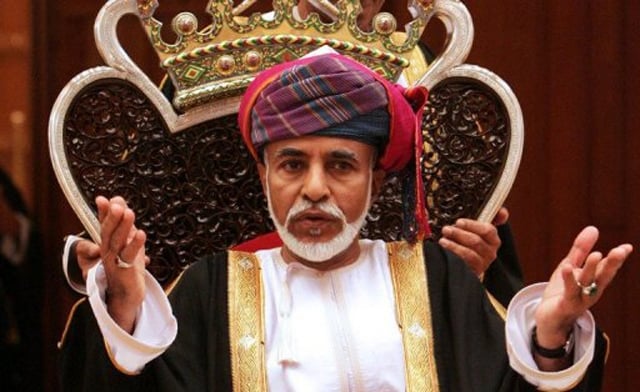Date: Mon, 27 Jun 2016 21:21:13 +0200
Whose Foot Will Drop in Oman?

Sultan Qaboos, who after 43 years in charge is the Arab world’s longest-serving leader(AFP)
Written by Shehab Al Makaleh
Since 2011, the Arab uprisings have engulfed much of the Middle East and North Africa, consuming the attention of publics and policymakers around the world. Indeed, while we pay close attention to the tragedies and (rare) triumphs that befall the region, perhaps we should be doing the opposite: looking to those nations left unscarred by revolution and upheaval.
What is it about their leadership and institutions that allowed them to survive and thrive? And what could potentially destabilize and upend these outliers?
The Gulf state of Oman, for one, has largely remained untouched by instability and, sadly, largely unnoticed by observers. Its stability is mainly attributable to the legitimacy and vision of Sultan Qaboos bin Said al-Said, the longest serving Arab ruler still in power.
Since ascending to the throne in 1970, Sultan Qaboos has transformed Oman from an impoverished Bedouin land into a prosperous nation with first-class infrastructure, a booming tourism industry, and a military agreement with the United States and the United Kingdom.
However, this trend may quickly come crashing to a halt. Sultan Qaboos is advancing in age, has no children, and has not announced who the next heir to the throne will be. And the sultan will likely be blocked from selecting the next heir himself due to the complex nature of the Omani political system.
This potential vacuum of power may leave the small-but-significant country in a precarious position in an already-unstable region. Sitting on major trade routes from Asia to the Middle East, Oman is a veritable “marine silk road” of energy and goods—its disruption would send economic ripple effects across the continent. Its strategic positioning and domestic politics also make it a high-profile target for terrorist groups as they seek to expand influence.
In the 1990s, the Omanis discovered that their oil reserves were smaller than previously thought, which prompted officials in Muscat to accelerate plans for a transition to a post-oil economy. Oman’s proven reserves are 5.15 billion barrels of crude oil, far less than other Gulf Cooperation Council states such as Saudi Arabia’s 268 billion, Kuwait’s 104 billion, the United Arab Emirates’ 98 billion, or Qatar’s 25 billion.
By 1995, Oman decided to take on the challenges stemming from the nation’s more modest oil reserves and production rates when officials announced the Vision 2020. Oman was one of the first Gulf States to implement a robust long-term plan to diversify its economy.
Nevertheless, the 70% slide in oil prices since mid-2014 has truly underscored the risks of Muscat’s overreliance on the Omani petroleum sector. And on June 17, Oman raised $2.5 billion in a bond sale arranged by five international banks to help meet its budget deficit.
The next Sultan, regardless of who they may be, must continue driving national efforts to diversify Oman’s economy and create new job opportunities in both the state and private sectors. Though Oman’s population grows at less than 4% annually, which is amongst the lowest in the Arab region, a lack of job opportunities threatens to send Omani youth to the streets in protest or join extremist groups offering lucrative economic opportunities.
Extremist groups in Yemen, such as al-Qaeda in the Arabian Peninsula (AQAP) and the Islamic State (ISIS) as well as other radical groups, will likely threaten Oman’s security in the post-Qaboos era. The extremists of AQAP are less than 500 kilometers from Oman’s Salalah port. This strategically located port is home to one of the world’s busiest shipping lanes and connects the Middle East to key markets in Asia and Europe.
As a partner in trading and counter-terrorism, Oman has a cautious yet optimistic future with the United States. The Sultanate became the first Gulf Arab state to enter a formal defense relationship with Washington, signing a “facilities access agreement” in April 1980, which granted U.S. military forces access to the Sultanate’s military bases. From time to time, the U.S still accesses the Masirah Island as deemed necessary to support Muscat. Oman has also helped the Obama administration empty out the Guantanamo Bay detention facility by accepting about half of the inmates released since January 2014.
U.S. officials, however, should recognize the extent to which their counterparts in Muscat take pains to decrease the visibility of Oman’s military partnership with Washington. In terms of Muscat’s alliance with Western powers, Omani authorities must consider the risk of extremists portraying the Sultanate as a Western ‘puppet.’ The next Sultan must continue to strike a balance between allying itself with strong powers, yet maintaining its own autonomy. However, Oman has a key comparative advantage here: its national fabric is based on tolerance, dialogue, and nonviolence within the Omani community.
While there is much speculation over the next heir to Sultan Qaboos, potential successors must be ready to face a number of strategic trials. These challenges, in the hands of the wrong leader, threaten to unravel decades of progress and stability. But with a strong and capable successor at its helm, the country holds promise to remain a steady bulwark of security and prosperity in a fractured region.
Shehab Al Makaleh is the President of the prominent Jordanian think tank Geostrategic and Political Studies of the Middle East Media.